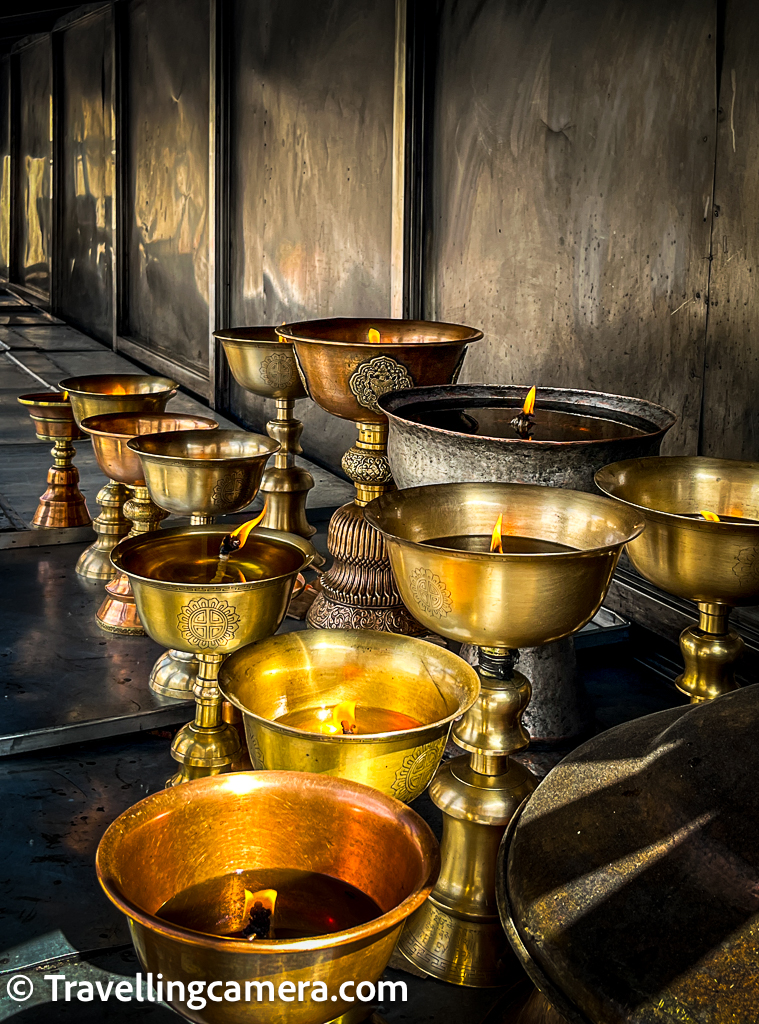Nestled amidst the rugged landscapes of Ladakh, Likir Monastery is a beacon of spiritual and historical significance. Known for its stunning architecture, rich history, and serene natural surroundings, Likir Monastery is a must-visit destination for anyone exploring the mystical region of Ladakh. This detailed blog post delves into the history, cultural importance, and natural beauty of Likir Monastery, providing a comprehensive guide for travelers and history enthusiasts alike.
When we reach Likir Monastery, it was closed when we got there so we decided to have lunch at a nearby cafe. We had thukpa and chai. Other people tried momos and omelet. After that, we climbed up the steps to the monastery. It was quite a beautiful one with a lovely museum.
A Glimpse into the History of Likir Monastery
Foundation and Early Years
Likir Monastery, also known as Likir Gompa, was founded in the 11th century by Lama Duwang Chosje under the patronage of King Lhachen Gyalpo. The monastery belongs to the Gelugpa sect of Tibetan Buddhism, which is known for its strict monastic discipline and scholastic traditions. The name "Likir" means "The Naga Encircled," symbolizing the protective deities believed to guard the monastery.
Historical Significance
Throughout its history, Likir Monastery has played a crucial role in the spiritual and cultural life of Ladakh. It has served as a center for Buddhist learning and meditation, attracting monks and scholars from across the region. The monastery's influence extended beyond religious practices, contributing to the preservation and propagation of Tibetan Buddhist culture and art.
Renovations and Restorations
Over the centuries, Likir Monastery has undergone several renovations and restorations. One of the most significant renovations took place in the 18th century under the patronage of King Tsewang Namgyal II. These efforts have helped preserve the monastery's ancient murals, statues, and architectural features, ensuring that they continue to inspire awe and reverence in visitors.
Architectural Marvels of Likir Monastery
The Main Assembly Hall (Dukhang)
The main assembly hall, or Dukhang, is the heart of Likir Monastery. This hall serves as the primary venue for religious ceremonies, prayers, and teachings. The walls of the Dukhang are adorned with intricate murals depicting scenes from Buddhist mythology, the life of Buddha, and various deities. The vibrant colors and detailed artwork reflect the artistic mastery of the monastery's creators.
The Avalokiteshvara Statue
One of the most iconic features of Likir Monastery is the colossal statue of Avalokiteshvara, the Bodhisattva of Compassion. Standing at 23 meters (75 feet) tall, this magnificent statue overlooks the monastery and the surrounding valley, symbolizing the protective and compassionate nature of Avalokiteshvara. The statue, which was installed in the late 20th century, has become a significant pilgrimage site for Buddhists and a major attraction for tourists.
The Library and Museum
Likir Monastery houses an extensive library containing ancient Buddhist scriptures, texts, and manuscripts. The collection includes rare and valuable works that provide insights into the teachings of Buddhism and the history of the monastery. Additionally, the monastery features a small museum showcasing religious artifacts, traditional costumes, and ceremonial items, offering visitors a deeper understanding of Ladakhi culture and heritage.
The Natural Beauty Surrounding Likir Monastery
Panoramic Views
Situated on a hilltop, Likir Monastery offers breathtaking panoramic views of the surrounding landscape. The monastery is surrounded by the rugged mountains of the Ladakh Range, with the snow-capped peaks providing a stunning backdrop. The lush green fields and traditional Ladakhi houses in the valley below add to the picturesque scenery, creating a serene and tranquil environment.
The Indus River Valley
The Indus River flows through the valley near Likir Monastery, adding to the natural beauty of the area. The river, with its crystal-clear waters and verdant banks, is a vital lifeline for the region, supporting agriculture and providing water to the local communities. The river's presence enhances the sense of peace and harmony that permeates the monastery and its surroundings.
Flora and Fauna
The area around Likir Monastery is home to a variety of flora and fauna. The region's unique climatic conditions support diverse plant life, including wildflowers, shrubs, and trees. Wildlife enthusiasts may also spot various bird species and small mammals that inhabit the area. The natural beauty of Likir, combined with its spiritual ambiance, makes it a perfect destination for nature lovers and meditation practitioners.
Visiting Likir Monastery
How to Get There
Likir Monastery is located approximately 52 kilometers west of Leh, the capital of Ladakh. The monastery is accessible by road, and the drive takes about 1.5 to 2 hours. The journey offers stunning views of the Ladakhi landscape, with the winding roads and scenic vistas adding to the adventure.
Location: Likir Village, Leh District, Ladakh, India
Distance from Leh: Approximately 52 kilometers (32 miles)
Best Time to Visit
The best time to visit Likir Monastery is from May to September, during the summer months when the weather is pleasant and the roads are clear. The winter months can be harsh, with heavy snowfall making travel difficult. Visiting during the summer allows travelers to fully appreciate the natural beauty and cultural richness of the area.
Accommodation
For those wishing to stay near Likir Monastery, there are several guesthouses and homestays available in Likir Village. These accommodations offer a comfortable and authentic Ladakhi experience, allowing visitors to immerse themselves in the local culture and lifestyle. Additionally, Leh offers a wide range of accommodation options, from budget guesthouses to luxury hotels, for those who prefer to stay in the city.
Likir Monastery is a jewel in the crown of Ladakh, offering a unique blend of spiritual heritage, architectural beauty, and natural splendor. Whether you are a history enthusiast, a spiritual seeker, or a nature lover, a visit to Likir Monastery promises an unforgettable experience. As you explore the ancient halls, admire the breathtaking views, and immerse yourself in the tranquil ambiance, you will gain a deeper appreciation for the rich cultural and spiritual legacy of Ladakh.
Related Blogposts -


























.jpg)
Comments